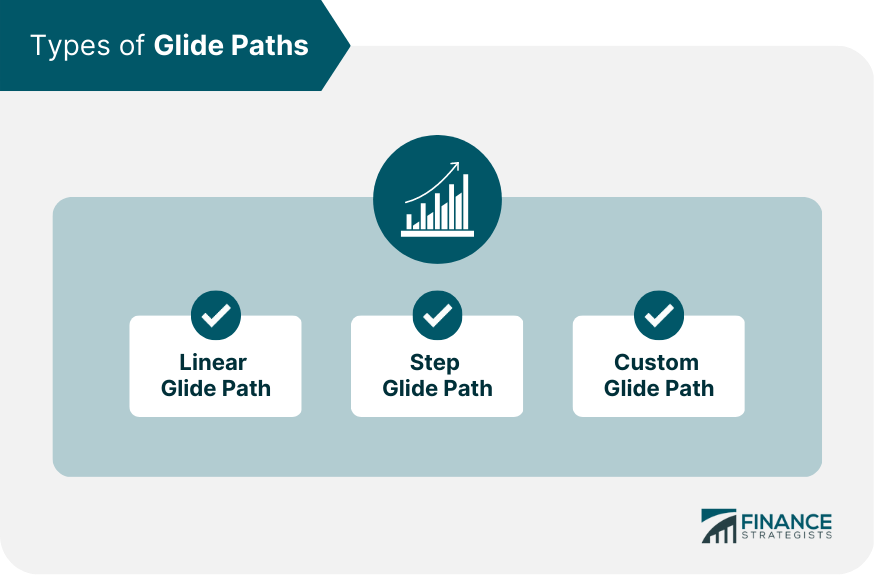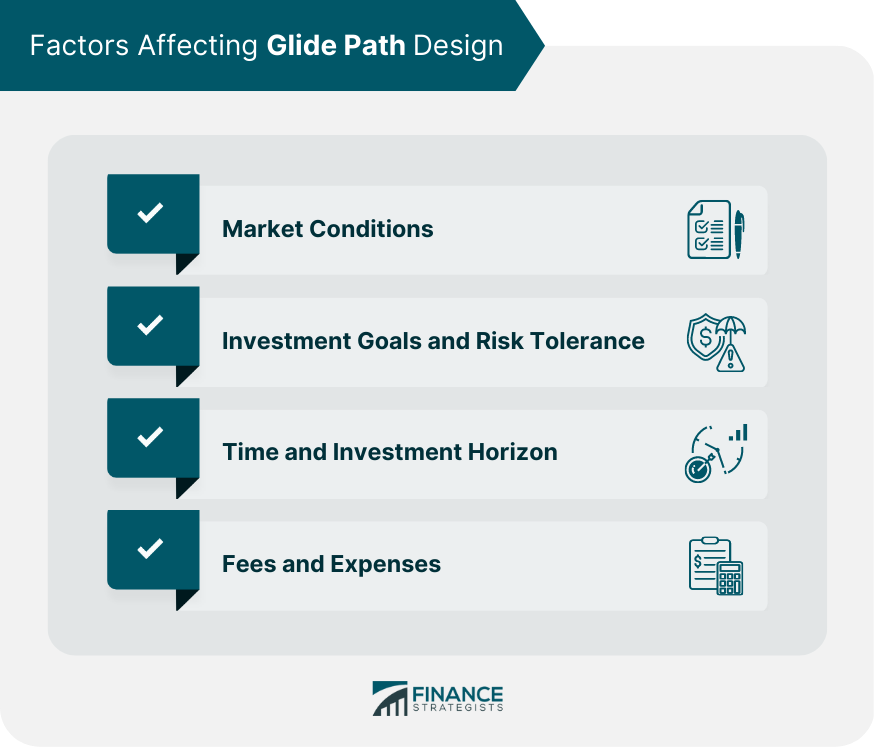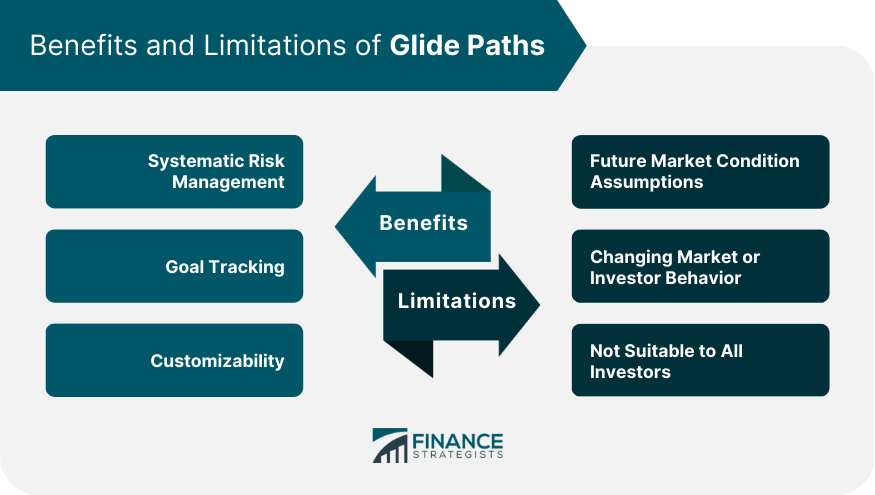Glide path is a term used in finance and investments to describe the systematic adjustment of an investment portfolio's asset allocation over time. The purpose of a glide path is to manage risk and optimize returns as the investor approaches a specific target date or time horizon, such as retirement. Essentially, a glide path is a plan for how an investment portfolio will shift from a more aggressive investment strategy to a more conservative one over time. The specific allocation percentages will depend on the individual investor's goals, risk tolerance, and time horizon. As people approach retirement, the need for a more conservative investment strategy generally increases. This is because investors have less time to recover from market downturns and can not afford to take on as much risk as they could when they were younger. Glide paths provide a framework for managing this transition from a more aggressive to a more conservative investment strategy. The purpose of a glide path is to ensure that an investment portfolio's asset allocation is appropriate for the investor's goals, risk tolerance, and time horizon. By systematically adjusting the portfolio's asset allocation over time, the investor can manage risk and optimize returns while ensuring that the portfolio is aligned with their changing needs. There are several types of glide paths that investors can use, each with its own characteristics. One common type is the linear glide path, which involves a consistent shift from a more aggressive to a more conservative investment strategy over time. Linear glide paths tend to be simpler and easier to understand. For example, the portfolio might start out with 80% equities and 20% fixed income and gradually shift to 20% equities and 80% fixed income as the investor approaches the target date. Another type is the step glide path, which involves more abrupt shifts in the asset allocation over time. Step glide paths can provide more precise control over the asset allocation. In this case, the portfolio might start out with 80% equities and 20% fixed income and then shift to 60% equities and 40% fixed income at a specific time, such as 10 years before the target date. A third type is the custom glide path, which is designed specifically for the investor's goals, risk tolerance, and time horizon. Custom glide paths can take into account a wide variety of factors, including the investor's expected income needs in retirement, expected market conditions, and the impact of taxes and fees on the portfolio. Custom glide paths can be highly personalized to the investor's specific needs, but they may require more effort to create and manage. Glide paths are a powerful tool for managing risk and optimizing returns: By gradually shifting the asset allocation from a more aggressive to a more conservative investment strategy over time, the investor can reduce the risk of major losses as they approach retirement. At the same time, glide paths can help optimize returns by maintaining a more aggressive investment strategy when the investor has a longer time horizon and can tolerate more risk. Investors achieve their retirement goals by gradually shifting the asset allocation from a more aggressive to a more conservative investment strategy. This allows investors to reduce the risk of major losses as they approach retirement. At the same time, they can maintain a more aggressive investment strategy when they have a longer time horizon and can tolerate more risk, potentially leading to higher returns over time. Glide paths can also help investors stay on track toward their retirement goals by automatically adjusting the portfolio's asset allocation over time. Designing an effective glide path requires careful consideration of a range of factors: In general, when market conditions are favorable, investors may be able to tolerate more risk and may benefit from a more aggressive investment strategy. Conversely, when market conditions are unfavorable, investors may need to reduce their risk exposure and shift to a more conservative investment strategy. Glide paths should be designed with these market conditions in mind to ensure that the asset allocation is appropriate for the investor's changing needs. Investors with more aggressive investment goals or higher risk tolerance may prefer a more aggressive glide path, while those with more conservative goals or lower risk tolerance may prefer a more conservative glide path. The specific asset allocation percentages will depend on the investor's individual needs and preferences. The time horizon refers to the length of time until the target date or retirement, while the investment horizon refers to the length of time that the investor plans to hold the investments. Investors with longer time horizons may be able to tolerate more risk and may benefit from a more aggressive investment strategy, while those with shorter time horizons may need to reduce their risk exposure and shift to a more conservative investment strategy. Higher fees and expenses can reduce the investor's overall returns and may require a more aggressive investment strategy to achieve the desired retirement goals. Conversely, lower fees and expenses may allow for a more conservative investment strategy while still achieving the same retirement goals. Glide paths should be designed with fees and expenses in mind to ensure that the investor's overall returns are maximized. There are several benefits to using a glide path in retirement planning. Investors can reduce the risk of major losses as they approach retirement by gradually shifting the asset allocation from a more aggressive to a more conservative investment strategy. At the same time, they can maintain a more aggressive investment strategy when they have a longer time horizon and can tolerate more risk, potentially leading to higher returns over time. This can help investors avoid the temptation to make emotional or impulsive investment decisions, which can lead to suboptimal outcomes. Instead, glide paths provide a clear framework for managing the investment portfolio and can help investors stay disciplined over the long term. Glide paths can be customized to meet the individual needs and preferences of the investor. This can include factors such as the investor's expected income needs in retirement, expected market conditions, and the impact of taxes and fees on the portfolio. By customizing the glide path to the investor's specific needs, investors can ensure that their retirement goals are aligned with their investment strategy. While glide paths offer several benefits, there are also some potential drawbacks and limitations to consider. First, glide paths are based on assumptions about future market conditions, which may not always be accurate. As a result, the actual performance of the investment portfolio may differ from what was expected based on the glide path. Glide paths can be impacted by changes in market conditions or investor behavior. For example, if market conditions are unfavorable, investors may panic and sell their investments, which could lead to suboptimal outcomes. Similarly, if market conditions are favorable, investors may become overconfident and take on too much risk, which could also lead to suboptimal outcomes. Glide paths need to be monitored and adjusted over time to ensure that they remain appropriate for the investor's changing needs. Investors with more complex needs or who require more customized investment strategies may not be well-served by a standardized glide path. These investors may benefit from working with a financial advisor who can provide more personalized guidance and investment advice. Glide paths are an important tool for investors to minimize the risk of significant losses as they near retirement by adjusting their asset allocation from a more aggressive to a more conservative investment strategy in a gradual manner. At the same time, they can maintain a more aggressive investment strategy when they have a longer time horizon and can tolerate more risk, potentially leading to higher returns over time. However, glide paths are not a one-size-fits-all solution, and investors need to carefully consider their individual needs and preferences when choosing a glide path. Factors such as market conditions, investment goals, risk tolerance, time horizon, and fees and expenses all need to be taken into account when designing a glide path. Additionally, investors need to be aware of the limitations of glide paths, including the potential impact of changes in market conditions or investor behavior. Investors should consider retirement planning services to ensure that their glide path is appropriate for their individual needs and preferences, and to monitor and adjust the glide path over time as necessary. With the right approach, glide paths can be an effective way to achieve financial security and peace of mind in retirement.Definition of Glide Path
Types of Glide Paths
Linear Glide Path
Step Glide Path
Custom Glide Path

Uses of Glide Paths
Manages Risk and Optimizes Returns Over Time
Helps Investors Achieve Their Retirement Goals
Factors Affecting Glide Path Design
Market Conditions
Investment Goals and Risk Tolerance
Time and Investment Horizon
Fees and Expenses

Benefits of Glide Paths
Systematic Risk Management
Goal Tracking
Customizability
Limitations of Glide Paths
Future Market Condition Assumptions
Changing Market or Investor Behavior
Not Suitable to All Investors

Final Thoughts
Glide Path FAQs
A glide path is a gradual shift in the asset allocation of an investment portfolio from a more aggressive to a more conservative strategy over time as an investor approaches retirement.
The three types of glide paths are linear, step, and custom. Linear glide paths involve a gradual shift in asset allocation over time, step glide paths involve a series of predetermined steps, and custom glide paths are highly personalized to an investor's specific needs.
Glide paths can help investors manage risk and optimize returns over time by gradually shifting the asset allocation from a more aggressive to a more conservative investment strategy as they approach retirement. They can also help investors stay on track toward their retirement goals by automatically adjusting the portfolio's asset allocation over time.
Market conditions, investment goals and risk tolerance, time horizon, and fees and expenses all play a role in designing an effective glide path.
Glide paths are based on assumptions about future market conditions, which may not always be accurate. They can also be impacted by changes in market conditions or investor behavior, and may not be suitable for all investors. Additionally, glide paths require ongoing monitoring and adjustment to ensure they remain appropriate for the investor's changing needs.
True Tamplin is a published author, public speaker, CEO of UpDigital, and founder of Finance Strategists.
True is a Certified Educator in Personal Finance (CEPF®), author of The Handy Financial Ratios Guide, a member of the Society for Advancing Business Editing and Writing, contributes to his financial education site, Finance Strategists, and has spoken to various financial communities such as the CFA Institute, as well as university students like his Alma mater, Biola University, where he received a bachelor of science in business and data analytics.
To learn more about True, visit his personal website or view his author profiles on Amazon, Nasdaq and Forbes.











